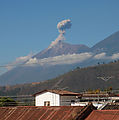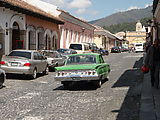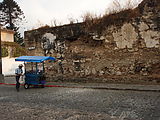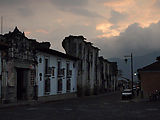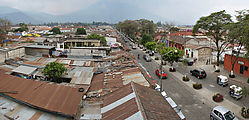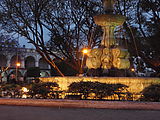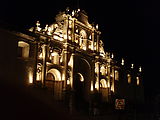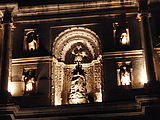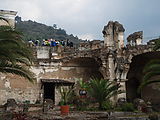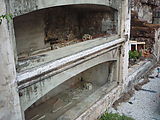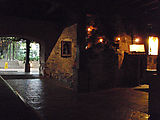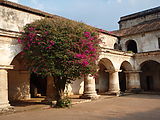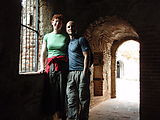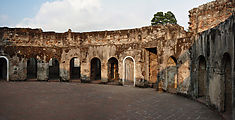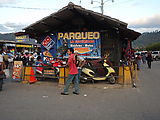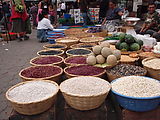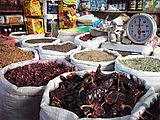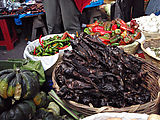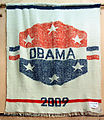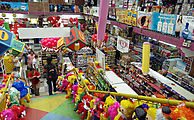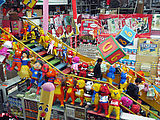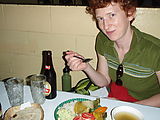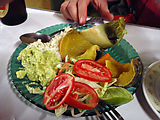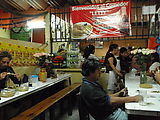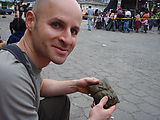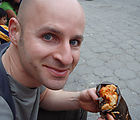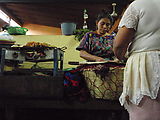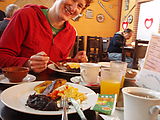Antigua
We started our Guatemala trip in the small city of Antigua
, which is
short for La Antigua Guatemala (old Guatemala). Antigua has cobblestone
streets, colonial architecture, and is surrounded by volcanoes.

 14.5570, -90.7340
14.5570, -90.7340
Our hotels often had roof access, providing great views. These photos below are taken from the hotels La Casa de Santa Lucia #2 and #3, both in the western part of Antigua. These hotels were decent, quiet, and well run — costing Q183 (about US$23) per night for two people with a private bathroom.
As we settled into a new country and a new pace, we also spent time just wandered the streets of Antigua, noticing interesting little details and tidbits — like these door knockers & keyholes. And then there were the fountains in the Parque Central, with water coming from women's breasts!
Churches & Ruins
The church of La Merced (an impressive, yellow mustard church) was next door to our hotel, and so we passed it often.
There were lots of churches in Antigua, some restored...
...but many are still in ruins from years of earthquake damage. The last major earthquake happened in 1773, when the capitol was moved from Antigua to its current location (Guatemala City).
Some ruins, like those of Hermano Pedro next to the church of San Francisco, provide opportunities for hours of exploration, with plenty of nooks, tunnels, and crumbly stairways.
Others, like El Carmen, can't be entered, but are still beautiful even in their ruined state.
Another way Antigua has made use of its extensive collection of ancient ruins is to incorporate them into a lavish hotel! Casa Santa Domingo was built among the ruins of another colonial-era convent — skeletons and all! We didn't stay the night there, but many recommend making the splurge. Casa Santa Domingo is at least worth a walkthrough, as it's a beautiful place.
Las Capuchinas
Las Capuchinas is a convent where, in the late 1700's, 25 nuns spent their lives in cells isolated from the outside world. Today, two of these cells are restored, complete with mannequin nuns (which are startlingly creepy!).
Downstairs, below the "tower" with its ring of cells, is a strange dark circular storage room.
Local couples now drop in to use the convent's gardens for privacy — which is especially convenient for them, as their cost is significantly cheaper than what the tourists pay (Q2 vs. Q30).
Markets
We have found from our previous experiences traveling in Mexico that the local market is often one of our favorite places to see. And the market in Antiqua did not disappoint! When we first arrived in Guatemala, it was late in the day by the time we reached Antigua — so we were delighted to find that much of the market activity was still in full swing into the evening. We learned later that Thursdays and Saturdays are the major market days in Antigua.
Markets tend to be found next to bus stations, allowing easy access for out of town visitors. These markets are not your typical grocery store — imagine an entire city block of covered stalls with every type of food, clothing, or household item you can imagine. Some parts of the market have certain types of products grouped together — the meats and seafood tend to be in more permanent stalls (to maintain some level of health code?). The clothes, music, backpacks, and hardware tend to be in another area. The Antigua market has seas of clothes -- racks upon racks, piles upon piles of clothes! But then... the food! Much of the fruits and vegetables are in one area, but sometimes you find a woman selling her homemade tamales in amongst the backpacks.
Lots of people sold what seemed to be the very same goods. How were we supposed to decide to buy from one particular woman instead of from her twenty neighbors? Price? Quality? We never purchased enough fruit and veggies to find out.
We loved buying foods we hadn't tried before, or those local fruits we knew would have a whole new flavor here in Guatemala (where they were grown — rather than being picked green and shipped to the U.S.). Slowly walking through the market, randomly picking directions (shall we turn left? right?) often led us in circles, but we always encountered wonderful new colors, smells, and experiences.
Bargaining is the norm in these markets, and we had little experience with it before. Also, as we were always buying our fruit in ones and twos (for snacks, or just something novel to try), we had especially little bargaining power.
Below you'll see some of the market items — including some interesting dried foods (beans and chili peppers, along with fish and iguanas).
We happened to arrive in Guatemala almost at the time of Carnaval (Carnival — a celebration like our Mardi Gras), so there were piles upon piles of confetti for sale. In Guatemala, a Carnaval tradition is for the kids to make cascarones , which are filled egg shells that are thrown like little confetti grenades.
One day we went to an amazing artisan market called Nim Po't , which had crafts from all over Guatemala & Central America, including this hand-made blanket featuring "OBAMA 2009"!
Other than the traditional mercados, Guatemala also has department stores. La Bodegona (located at 4 Calle Poniente & Alameda Santa Lucia), was also curious to explore. This huge store was as wide as a full block, and was crammed with everything from groceries to school supplies to piñatas.
Food
We weren't afraid to risk trying some of the food in the markets, despite the warnings of possible health concerns. We were famished after a long wander through the market, and finding the comedor section (food court), we stopped for a snack at Comedor Letty. Letty had lots of customers, unlike many of the other comedors at that hour. Must be good! We shared a plate of cooked squash and other root veggies, a vegetable soup, and our favorite — handmade corn tortillas. Of course, to celebrate our arrival, we had a few bottles of Gallo , the beer of Guatemala.
We also ate many fresh tamales.
Oh, the new things we tried! On our second morning in Antigua, we started our daily habit of experimenting with new fruits from the market: cherimoya (yum, like pudding!), mango, and jocote marañón. The jocote marañón is the "false fruit" of a cashew . It was somewhat astringent and slightly fruity — but probably not something we'd go out of our way to eat again. The cashew itself cannot be eaten (without special processing), as it is enclosed in a poisonous shell!
Oh, and actual restaurants? We found lots of good food in Antigua! We loved going to comedores (diners) for traditional breakfasts (deseyunar tipico) of eggs, black beans, fried plantains, and cream or hard white cheese (queso), along with orange juice, tea, or Guatemalan coffee. For lunch & dinner, we sought out interesting native sauces , especially the dark rich salsa pepian. A few other foods we enjoyed were pastel de elote (literally "corn cake" but sweeter than our cornbread), piloyada (a traditional large red bean salad), and chimol (a shredded radish salad).
Some of our favorite restaurants:
- Comedor Típico Antigueno - A perfectly good, standard comedor near the bus station.
- La Cuevita de los Urquizu - You can have your choice of a main entrée from one of their sauce pots, along with a choice of several salads. Closes earlier than you might expect. (At 2 Calle Oriente 9)
- La Fonda de la Calle Real - This was the fanciest restaurant we tried. It came highly recommended by numerous people and sources. There are three restaurants with the same name — we liked the one furthest north (at 3 Calle Poniente 7) for its selection of sauces and atmosphere.
- El Sombreron - a bakery. We tried lots of tasty dulces (sweets) from there.

